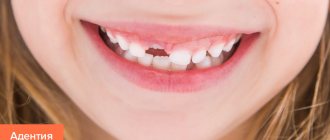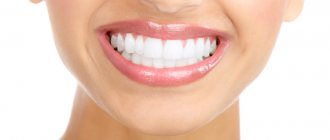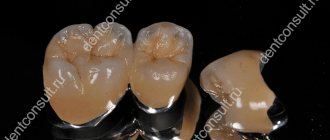Types of toothache that go to your head
Dental problems can have different manifestations. One of them is acute pain that radiates to the jaw, temporomandibular joint, temples, and can also cover the entire surface of the head. Diseases can occur due to inflammation of tissues, injuries and abnormalities in the structure of bones and joints, and damage to teeth. A common feature for them is a tendency to constant progression, so the diseases require timely treatment.
Caries
Caries is a disease with a slow but progressive course. It begins with damage to the enamel and continues with the destruction of the internal structures of the tooth. In the future, the disease can be complicated by inflammation of the pulp, as well as periodontitis. Doctors identify a number of reasons that can lead to the development of caries:
- the presence of hard plaque and stones on tooth enamel;
- insufficient oral hygiene, as a result of which microorganisms have a detrimental effect on the enamel;
- anatomical features, the presence of gaps and spaces between teeth;
- the concentration of fluoride in the enamel - the lack of this element increases the sensitivity of the teeth.
Tooth decay can damage the deep structures of the tooth, leading to nerve inflammation. This process is accompanied by acute, throbbing pain that can spread to the entire jaw and radiate to the head. Treatment consists of removing damaged tooth structures and installing a filling; if necessary, complete tooth extraction is performed. According to the decision of the doctor and the patient, implants are installed.
Cyst
A cyst is a pathological cavity surrounded by a capsule. It appears near the root of the tooth as a result of caries, as well as when an infection occurs during dental prosthetics or installation of crowns. Pathogenic microorganisms cause inflammation, which is controlled by the immune system. However, the tissues are destroyed, and a dense protective capsule is formed around them. The process can progress, which is dangerous due to the destruction of the jaw bones, rupture of the cyst and the entry of decay products into the bloodstream. It is important that the cyst may not show any symptoms in the early stages, but requires urgent removal immediately after its discovery.
Displacement of the jaw head
One of the reasons why dental problems are accompanied by headaches is dysfunction of the temporomandibular joint. It is paired and normally symmetrical, provides mobility to the lower jaw and connects it to the bones of the skull. He is constantly in motion and takes part in many processes: chewing, swallowing, speaking, yawning and others. The joint is formed by the fossa of the temporal bone and the head located on the lower jaw. Incorrect position of this particular element leads to dysfunction of the joint.
There are a number of reasons that can cause temporomandibular joint dysfunction:
- malocclusion;
- removal or loss of teeth;
- quick erasing of chewing surfaces;
- injuries, jaw fractures, pathologies during rehabilitation;
- high speech load.
Temporomandibular joint dysfunction can be diagnosed by characteristic signs: a clicking sound when opening the mouth, pain in the temples, difficulty moving the lower jaw. However, these diseases can also present with atypical symptoms, including headache, hearing and vision impairment, snoring and sleep apnea.
Other reasons
Headaches can be a manifestation of acute and chronic dental diseases. A more detailed examination reveals various abnormalities, including:
- inflammatory diseases of the teeth and oral cavity;
- incorrect installation of implants, errors in prosthetics;
- inflammation or mechanical compression of the dental nerve;
- malocclusion is often a congenital pathology that can be corrected in childhood;
- arthrosis, arthritis of the temporomandibular joint caused by various factors.
It is impossible to make an accurate diagnosis at home, so it is important to consult a specialist in time for examination. It is important to remember that some diseases are asymptomatic in the initial stages, and their manifestations may be atypical. Thus, toothache must be distinguished from migraines and other types of headaches.
Finding the cause – who to contact?
Many people take a pill for a headache without thinking about the sources of discomfort. In case of frequent attacks, it is necessary to consult a therapist, a neurologist, a dentist, an otolaryngologist, an endocrinologist, a gastroenterologist, or an orthopedist. After all, there is a relationship between systems and organs. The oral cavity is the entrance gate to the body. If there is a headache and pain in the teeth, the general practitioner will refer the patient to the dentist. True, many patients are afraid to sit in the dental chair. It is important to choose a clinic that uses modern technologies, new methods of pain relief, and sedation.
Therapeutic procedures are prescribed by the attending physician after a complete diagnosis and study of the symptoms. The optimal method for eliminating the root cause of the pathology is selected. The treatment technology is influenced by the following factors:
- Type of disease;
- Severity of the disease;
- Age and additional aspects;
To eliminate the problem, pulpitis treatment is sometimes required. First, the affected tissue is removed. The tooth is opened to expose the pulp chamber. After cleaning the canals and disinfecting, a filling is installed. In complicated cases, paracetamol and ibuprofen are prescribed; spasms are relieved by noshpa. Sachets and effervescent tablets may be recommended. Spasms are also treated with physiotherapeutic procedures such as electrophoresis, acupuncture, and darsonvalization of the collar area.
If a wisdom tooth hurts, if therapy is not possible, it is removed. Operations can be complicated by the fact that such chewing organs have curved roots. If you experience discomfort in the temples, jaws, back of the head, or crown of the head due to damage to the masticatory system, you may need to:
- correction of bite;
- performing relaxation exercises;
- the use of night pads, which reduces compression of the masticatory organs;
- refraining from biting nails, chewing gum;
It is important that therapy is approached comprehensively. The patient should visit a chiropractor. Then the dentist selects an orthopedic structure and fixes the correct position of the jaw. Proper treatment will eliminate the problem with the masticatory organs and relieve the patient of chronic pain in the temples, back of the head, and neck.
Diagnostic and treatment methods
An accurate diagnosis is made by a dentist based on the results of the examination and additional examinations. You may need X-rays of the jaw, computed tomography, as well as orthopantomography - a common technique for visualizing the stage of carious lesions and assessing the condition of fillings and crowns. The following methods are used for treatment:
- correction of bite using orthodontic structures (plates, braces, mouth guards);
- surgery to remove tumors, damaged teeth and nerves, and to treat caries;
- prosthetics, installation of implants.
If the doctor prescribes surgical treatment, conservative methods and medications are ineffective. They will help temporarily reduce the pain, but then the disease will progress. It is important to remove the main focus of the disease, cleanse the pathological area of microorganisms, pus and other substances, and then pay attention to proper recovery. If necessary, the dentist may prescribe additional routine examinations some time after successful treatment.
Symptoms
When visiting a dentist, the patient should immediately voice his symptoms. Based on the sensations described, an experienced dentist can immediately determine the nature of the pain. The pain can be aching in nature, as a rule, the sensations are the most vivid and unpleasant. If the entire lower or upper jaw aches, you should immediately contact the clinic.
However, most often the pain overtakes a person at night. In this case, you should not endure the pain; it is best to take a painkiller tablet. Acute pain usually manifests itself in the presence of serious pathological processes, for example, developing pulpitis, deep caries or periodontitis. In this case, the acute pain may be throbbing and may intensify with each new push.
Eating too hot or cold food can trigger severe pain. When it gets on the surface of a diseased tooth, piercing pain can immediately cover the entire jaw. However, unpleasant sensations are usually short-lived and decrease in the absence of the stimulus.
Prevention of dental diseases
Proper prevention of dental diseases should be carried out from an early age. This will help avoid many problems that lead to constant pain, acute and chronic diseases, as well as tooth loss. Doctors recommend the following methods of prevention:
- daily oral hygiene using toothpaste and rinses;
- removing plaque in the dental office when it appears;
- timely correction of bite and incorrect position of teeth;
- regular dental check-ups.
At the Clinical Brain Institute, you can undergo a comprehensive diagnosis of headaches, as well as receive recommendations for their treatment. Our center has modern equipment that allows you to quickly make an accurate diagnosis and establish the cause of pain. It is important to follow doctors’ instructions and go through all stages of treatment - this will help get rid of dental problems, correct bite and other congenital or acquired pathologies, and also prevent their further development.
Preventive measures
Why does my teeth hurt and my head hurt? This situation often arises due to improper lifestyle and care. How to prevent such an unpleasant phenomenon?
- Clean the units twice a day and rinse your mouth after every meal.
- Regular visits to the dentist every six months. Chewing organs have appeared - preventive measures are needed!
- You always need to get enough sleep. You should go to bed and get up at the same time. You need to learn to relax and rest.
- Eat a balanced diet of healthy foods regularly. Doctors do not advise eating smoked meats, fried foods, canned food, or drinking champagne.
- Walk in the fresh air and do as much physical exercise as possible.
It is useful to have emotional connections with friends and family, good relationships with neighbors and work colleagues. You cannot overestimate your capabilities. Work to the best of your ability, it is important to enjoy it. Speak out and express your emotions; it is harmful to accumulate negative thoughts and worry. Positive thinking, open smiles, laughter, and a cheerful mood give good results.
Insomnia and depression
During sleep, an extremely important biological process occurs - rest of the human nervous system. Therefore, it is important to have complete and high-quality sleep. Otherwise, a person cannot feel normal, the body does not work at full capacity. Bruxism, or teeth grinding during sleep, can interfere with sleep. Grandmothers' belief that it appears from worms is a myth. Grinding predominantly develops against the background of stress and depression. According to statistics, the vast majority of people currently have bruxism. At the same time, permanent is an extra load on the teeth, leading to their faster destruction, grinding, changes in bite, etc.
Poor quality sleep at night leads to fatigue, decreased performance and worsening stress and depression.
Go to sleep and get enough sleep. How to get rid of insomnia Read more
A person cannot control teeth grinding at night on his own, so he needs the help of specialists. Often, patients with this problem are recommended to wear a special device - mouth guards or splints, which are an ideal “arch support”. This device is placed on the lower jaw.
What to choose?
In most cases, malocclusion can be corrected with both braces and aligners - the choice is up to the patient. For those who have a low pain threshold, who have a hard time with discomfort and are worried that the treatment will be painful, we can recommend aligners. Thanks to their smooth surface, they are almost imperceptible and very comfortable to wear. And their effect, although effective, is at the same time softer than that of a metal brace system. Aligners allow you to minimize all the inconveniences of treatment and achieve your goal quickly and without pain.











